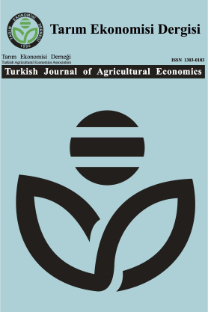Türkiye'de Önemli Gıda Ürünlerinin Talep Esneklikleri
Gıda ürünleri talep esnekliklerinin tahmini, gerek tarım ekonomisi ve gerekse uygulamalı ekonomik çalısmalarda önemli çalısma alanlarından biridir. Bu çalısmanın amacı Türkiye istatistik Kurumu (TÜIK) tarafından derlenmis olan kesit veriler kullanılarak Türkiye'de hanehalkları tarafından tüketilen önemli gıda ürünlerinin talep esnekliklerini tahmin etmektir. Çalısmada, 42 gıda ürününe ait talep modeli, gelir ve fiyat esnekliklerini tahmin etmek amacıyla Heckman iki asamalı tahmin yöntemi kullanılmıstır. Analiz sonuçlarına göre, gelir esnekliklerinin çogunlugu pozitif ve birden küçüktür. Hesaplanan gelir esnekligine göre, ekmek inferior (düsük mal) olarak saptanmıstır. Gelir esnekligi en yüksek olan ürünler ise sıgır eti, koyun eti ve keçi eti gibi kırmızı et ürünleridir. Gıda ürünleri fiyat talep esnekliklerinin büyük bölümünün ise birden küçük oldugu tahmin edilmistir.Kırmızı et, margarin, zeytinyagı, fındık ve sofralık zeytin fiyat esnekleri birden büyüktür.
Demand Estimation for Basic Food Products ib Turkey
Estimating demand elasticities for food commodities has been important research issues in agricultural and applied economics. The objective of this study is to estimate demand elasticities for important food products in Turkey by using cross sectional survey data from Turkish Statistical Institute (TurkStat). Heckman two-stage estimation procedure is used to estimate demand parameters, income and own-price elasticities for 42 food products. According to the results, most of the income elasticities are positive and lower than 1. Income elasticity shows that bread is an inferior good for Turkish consumers. Red meats such as beef, sheep and goat meat have the highest income elasticities among food commodities. Own price elasticities for most food commodities are inelastic, as expected. Red meats, margarine, olive oil, hazelnut and olive price elasticities are elastic.
___
- Akbay, C., 2004. “Talep Analizlerinde Tek ve Çok Denklemli Modellerin tahmini: Problemler ve Çözüm Önerileri.” Türkiye VI.TarımEkonomisi Kongresi. 16 18 Eylül. Gaziosmanpasa Üniversitesi,Tokat.
- Akbay, C., 2007. “Urban Households' Cooking Oil and Fat Consumption Patterns in Turkey: Quality Vs. Quantity.” Quality&Quantity. 41(6), 851-867.
- Akbay, C. ve Boz, I., 2001. “Food Consumption Patterns of Socioeconomics Groups: An Application of Cencored System of Equation,” ERC/METU International Conference in Economics / V. Meeting in Ankara, September 10-13, C6-117.
- Akbay, C., Chern, W. ve Boz, I. 2007. “Household Food Consumption in Turkey.” European Review of Agricultural Economics. 34(2), 209-231.
- Akbay, C., Chern, W. and Boz, I. 2008. “Household Food Consumption in Turkey: A Reply.” European Review of Agricultural Economics. 35(1), 99-102.
- Armagan, G. ve Akbay, C. 2008. “An Econometric Analysis of Urban Households' Animal Products Consumption inTurkey.”Applied Economics. 40(15), 2025-2032.
- Cox, T.L. ve Wohlgenant, M.K., 1986. “Price and Quality Effects in Cross-Sectional Demand Analysis.” American Journal of Agricultural Economics 68, 908-919.
- Greene, W. H. 2007. LIMDEP Version 9.0. Econometric Modeling GuideVolume 2,Australia.
- Heckman, JJ., 1976. “The Common Structure of Statistical Methods of Truncation, Sample Selection, and Limited Dependent Variables and a Simple Estimator for Such Models.”Annals Econ.And soc. Meas. 5, 475-492.
- Heien D. ve Wessells, C. R., 1990. “Demand System Estimation With Microdata: A Censored Regression Approach.” J. Business and Economic Statistics. 8(3), 365-371.
- Kmenta, J., 1986. “Elements of Econometrics.” 2 Ed., Mac Millan, USA.
- Koç A., Dolekoglu, T and Erturk, Y. E., 2001. “Household Vegetable Oil and Butter Demand in Turkey: AThree Stage Budgeting and AIDS with Adjusted Unit Value. Selected Paper, Contributed Paper “The Food Consumer in the Early 21 Century”, 71 EAAE Seminar,April 19-20, 2001 Zaragoza, Spain.
- Koç, A. ve Yurdakul, O., 1995. “Türkiye'de Gıda Harcamaları ve Gıda Ürünleri Için Gelir-Harcama Esnekligi Tahmini.” Çukurova Üniversitesi Ziraat Fakültesi Dergisi. 10(3), 175-188.
- Orhan, E., Akbay, C., Boz, I. ve Candemir, S., 2004. “Kesikli-Sürekli Modellerde Marjinal Etkilerin ve Talep Esnekliklerinin Tahmin Edilmesi: Hanehalkı Gıda Harcamaları Üzerine Bir Uygulama.” Türkiye VI. Tarım Ekonomisi Kongresi. 16-18 Eylül. Gaziosmanpasa Üniversitesi,Tokat.
- Özcan, K. M., Tan, S., Dellal, I., 2001. “Basic Food Consumption in Turkey: Effects of Income, Price and Family Size in UrbanAreas.” 71 EAAE Seminear, The Food Consumer In the Early 21 Century, Zaragoza, Spain.
- Park, J. L., Holcomb, R. B. ve Raper, K. C., 1996. “A Demand System Analysis of Food Commodities by U.S. Households Segmented by Income.” American Journal ofAgricultural Economics. 78, 290-300.
- Pazarlıoglu, M.V., Miran, B., Üçdogruk, S. ve Abay, C., 2006. “Using econometric modelling to predict demand for fluid and farm milk: A case study from Turkey.” Food Quality and Preference. 18 (2007), 416424.
- Pazarlıoglu, M.V., Miran, B., 2007. “Izmir'de Sıvı Yag Talebi: Yaklasık Ideal Talep Sistemi (AIDS) Uygulaması”, EKEV Akademi Dergisi. Yıl:11, Sayı:32.
- Sengül, S., 2002. “Türkiye'de Kentsel ve Kırsal Kesimde Gelir Gruplarına Göre Gıda Talebi.” Uludag Üniversitesi, Iktisadi ve Idari Bilimler Fakültesi Dergisi. 11(1), 257-282.
- TÜIK, 2003. “Hanehalkı Bütçe Anketi”. Türkiye Istatistik Kurumu,Ankara.
- ISSN: 1303-0183
- Yayın Aralığı: Yılda 2 Sayı
- Başlangıç: 1992
- Yayıncı: Tarım Ekonomisi Dergisi
Sayıdaki Diğer Makaleler
GAP Bölgesi'nde Kaliteli İçme Suyunun Fiyatlandırılmasına Etki Eden Faktörler
Bahri KARLI, Abdulbaki BİLGİÇ, Güneş EREN, Bülent MİRAN
Türkiye'de Önemli Gıda Ürünlerinin Talep Esneklikleri
Abdulbaki BİLGİÇ, Cuma AKBAY, Bülent MİRAN
Gap Projesi'nin Türkiye'nin Kırsal Kalkınma Politikaları İçindeki Yeri ve Önemi
